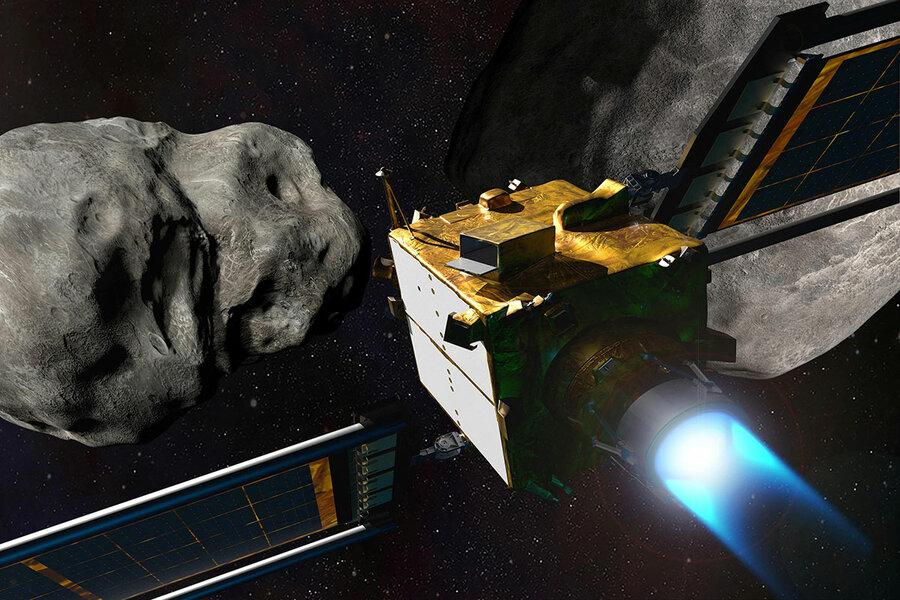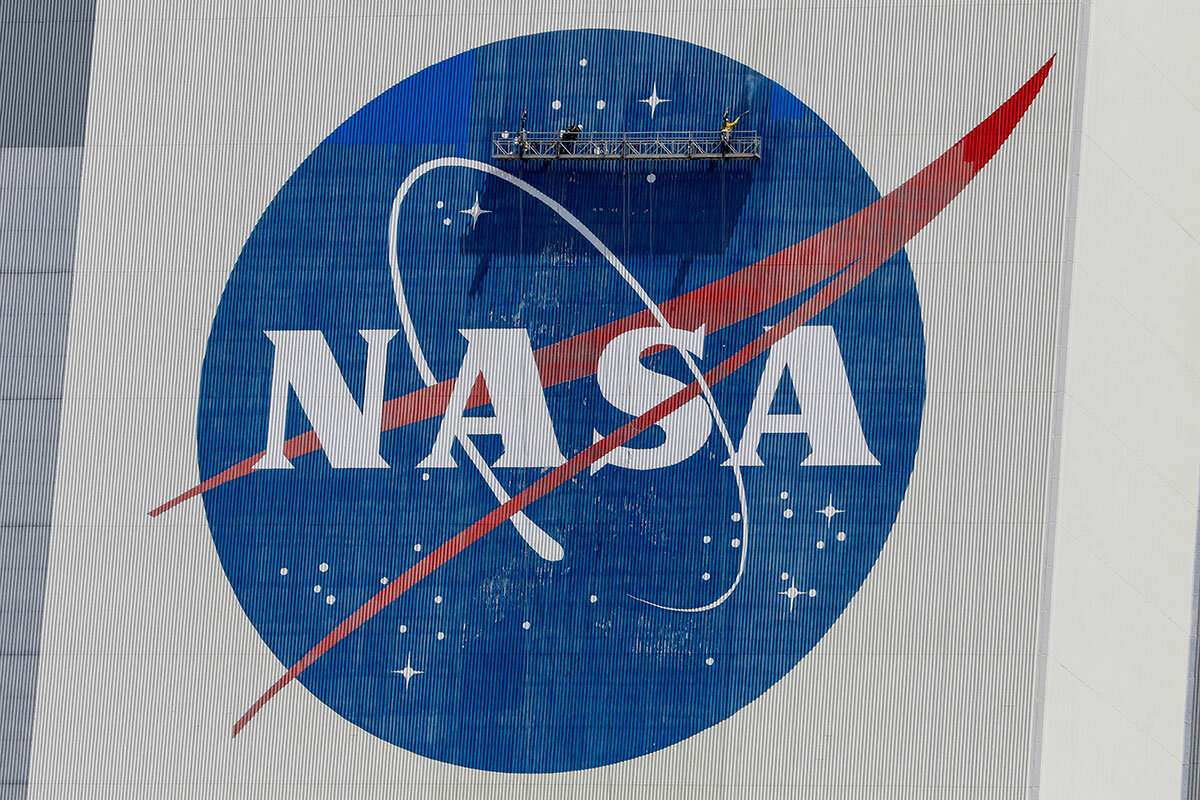Target practice in space: NASA aims to knock an asteroid off course
Loading...
Hollywood comes to life Monday night, as NASA attempts to smash a small spacecraft into an asteroid nearly 7 million miles from Earth, and knock the space rock onto a new path.
It’s a mission that could someday help save the planet.
The asteroid, called Dimorphos, is not heading toward Earth. In fact, it is no threat to Earth at all. But that is why NASA is using it for target practice. If the space agency can successfully nudge Dimorphos onto a new track, it can learn crucial lessons about how to defend Earth if a more dire situation were to occur in the future.
Why We Wrote This
A story focused onBy colliding into a distant asteroid that poses no threat, NASA’s DART mission is tapping scientific ingenuity to test the idea of deflecting space rocks for planetary defense.
By science fiction standards, the mission might appear a bit mundane – no nuclear explosions or roughnecks in space. The DART craft will simply crash into the asteroid. But unlike Hollywood movies, this story is advancing a real-life plotline of safeguarding Earth. There’s a real-life planetary defense officer involved. And in place of special effects, scientific hurdles are being cleared by real-life innovators.
“We have collided with things before, but not with the intent of moving them,” says Thomas Statler, DART program manager at NASA. “We are moving an asteroid. We are changing the motion of a natural celestial body in space. Humanity has never done that before,” he said in a Sept. 22 press briefing.
The mission itself will be successful if DART collides with the asteroid.
“It’s really hard to hit a very little object in space and we are going to do it,” says Elena Adams, the mission systems engineer on the Johns Hopkins University Applied Physics Laboratory management team, which has developed and led the project for NASA.
While the goal is straightforward, the road to Monday was no simple one. And the mission’s work won’t end with the crash.
“There’s a lot of stuff going on,” NASA’s Dr. Statler explains in an interview. “There are the astronomical observations. There’s the physical computer simulations of the impact. There’s what happens to the spacecraft. And the more you start digging into this from the science side, the more intricate each one of these things becomes.”
A smashing success?
One early task for mission scientists was locating the right rocky object in space.
They found it in Dimorphos, one of two asteroids that move together in what’s called a binary asteroid system. (Hence the name DART, which stands for Double Asteroid Redirection Test). Dimorphos orbits the larger Didymos in a system that was first spotted in 1996.
By hitting Dimorphos, scientists will be able to observe how much that orbit changes.
A second challenge is the collision’s physics: changing the course of a large object with a much smaller one. One everyday example of redirection is any time one moving billiard ball hits another moving one – but in this case the two objects aren’t similar in size. The core of the DART probe is about the size of a refrigerator. Dimorphos is about 525 feet in diameter.
What DART has going for it is speed. By having DART collide with the asteroid at an expected 4 miles per second (15,000 miles per hour), the goal is an impact that reduces Dimorphos’ speed by a fraction of 1%.
That could be enough to prove this concept of asteroid redirection for future planetary defense. In other words, if a Dimorphos-size asteroid were heading toward Earth, that would be a real threat. And slowing it just a fraction when it is still far away would be enough to avert a catastrophic impact.
Staying on target
Mission engineers have developed targeting algorithms for the craft to guide itself and ensure it hits Dimorphos, not Didymos. A large solar array will help the craft build velocity, powering an electric propulsion engine.
“A lot of new technologies have been tested on this spacecraft ... the new solar panels, new propulsion making the spacecraft more autonomous to be able to actually do this right,” says Jay McMahon, an aerospace engineer at the University of Colorado Boulder who is helping analyze the mission. “We can’t have humans operating a joystick because things are happening so fast, so the spacecraft has to make its own decisions.”
The most challenging aspect might be the steering. Largely on its own, the spacecraft will have to hit a relatively small mass of unknown shape. “A huge piece of what the DART piece is demonstrating is, do we have what it takes to autonomously navigate our spacecraft to autonomously crash into this small body?” says mission scientist Mallory DeCoster, who will help investigate the impact.
Calculating the results from Earth
One of the big tests for researchers won’t come until after tonight’s collision: measuring what happened.
Dimorphos orbits once every 11 hours and 55 minutes. The goal is to slow Dimorphos’ orbit by as much as 10 minutes. Scientists will confirm whether they were successful with Earth-based telescopes, measuring the variations in brightness that happen as Dimorphos orbits the larger asteroid. Definitive results won’t be available for a week or more.
Glimpsing changes in a relatively small object 7 million miles away isn’t easy, which made this part of the mission a hurdle.
“I think it became a challenge for the team to kind of circle back and say, OK, how do we combine all of these different pieces of understanding to wind up with a measurement ... that’s definitive,” Dr. Statler says. “And I think that took quite a long time and quite a lot of development of workflow and information flow.”
Journey began long before launch
The road to DART began in 2005, when Congress tasked NASA to test and confirm a method to protect Earth in case of an asteroid impact. The years since have been spent figuring out how to do it, with the mission formally starting in 2015 and the spacecraft launch last November.
“We do things because they’re hard,” says DART Program Manager Ed Reynolds, who is thrilled the efforts are finally coming to fruition. “We are at the point where technology is emerging so that we can use these emerging technologies to protect ourselves against these threats.”
NASA scientists – and the public – will get a front-row seat to the collision, thanks to an onboard camera named DRACO (Didymos Reconnaissance and Asteroid Camera for Optical navigation) and a live feed.
Rallying to save the planet from asteroids – or failing to do so – has for decades seeped into public thought through movies such as “Armageddon” and the more recent “Don’t Look Up.” But the job is a real one.
And for one night at least, the DART mission has scientists and amateur asteroid watchers alike thinking “Do look up.”
John Stoffel is an avid sci-fi reader and one of those excited watchers. “It’s such an interesting mission,” he says. “And since we’ve only visited a handful of asteroids, each one tells us more about the solar system and what we can maybe expect to find there as we explore more.”
The collision is scheduled to occur at 7:14 p.m. ET Monday. You can watch it here, live.







